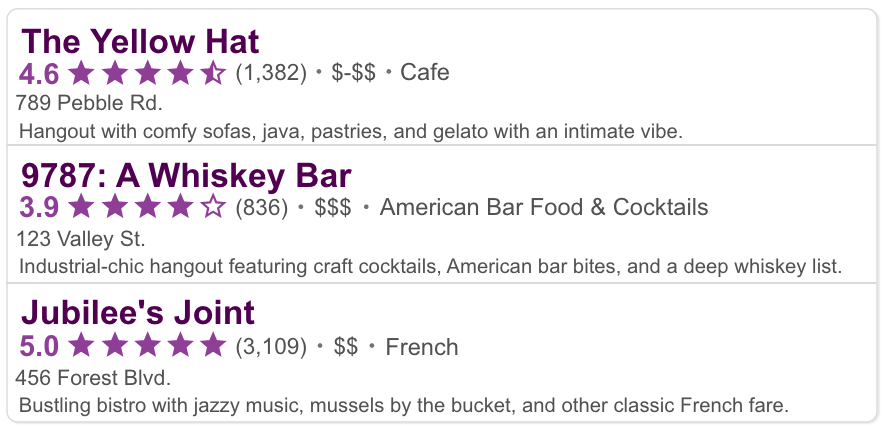Anytime Google updates their search experience, the subtle change seems to be snuck into the search engine overnight to either gently surprise the detail-oriented or to otherwise go unnoticed. However, one of Google’s most impactful, and definitely most noticeable changes, was the introduction of the Action-Oriented search result. Ever search for “dinner near me?” Your results used to be a never-ending list of blue links that came from a variety of sources. At a basic level, there was no clear way to know if the link you were clicking on would take you to a site that contained some or all of the information you needed, like if the restaurant was open, if they accepted reservations, if it was expensive, or what kind of food they served. A more advanced look at the results would allow you to view the ‘need-to-know’ information for multiple sources, preventing you from bouncing between multiple web pages and the search results. And while the ubiquitous list of blue links hasn’t disappeared, the user now sees something akin to the ‘advanced look’ described above:
Gone is the never-ending list of links! In their stead, we now have a widget, of sorts. We see a map: cued by the phrase ‘near me,’ a variety of GPS-oriented pindrops give us a bird’s eye view of restaurants and other eateries in proximity to the searcher. Additionally, beneath the interactive map, we have a short list of featured restaurants that meet the requirement of ‘near me.’ Along with the name of each of those restaurants, we have a grab-bag of other useful information like:
In different iterations of this type of result, we’ve also seen a hyperlinked phone number that, when clicked while viewing the result on a mobile device, would auto-fill your native call application with the restaurant’s number.
So, what makes this type of result ‘Action-Oriented?’ While the information featured appears as a single result, it is actually comprised of a very curated list of various data points. When presented together, this collection of data points allows the searcher to find and decide the answer to their original query very quickly. It’s the type of data points presented together in response to, and in combination with, the query that presuppose the desired action the searcher wants to take. Someone searching for “dinner near me” is looking for several things: (1) restaurants at which to have dinner that are both (2) open and (3) geographically near to where the searcher is presently located. Those are the factors that are givens or those that are otherwise non-negotiable and assumed to be shared by all results included in that action-oriented result. The rest of the information provided, like the price range and the type of food offered, are deciding factors. These data points are negotiable from the viewpoint of the search engine and it’s ultimately up to the searcher to decide which of these factors are important to them.
Action-Oriented Results can be created for a variety of result types regardless of your company’s goals. This custom result type can help connect a shopper to an item just as well as they can connect employees to information. For example, one of our clients recently benefited from a major redesign of their office space. This redesign included a multitude of additional meeting rooms, all of which had various features and furniture. They also had new room names. And while the rooms were impeccably designed and easy to book, no one knew what amenities an individual room featured. This meant that all-day workshop sessions were booked in rooms without chairs and meetings with 50+ attendees were held in rooms meant for groups of about ten people. Not knowing what kind of room you were booking was a major pain point for this fast-moving organization. As part of our Search Strategy and Design workshop, one of the results we transformed into a prototype AOR was a ‘Room’ result type.
As evident in the image above, the user could search for a meeting room and find all of the information they needed to determine whether or not that room would suit their needs. In addition to a picture of the room itself, we included a list of the available amenities, a graphic map highlighting where the room was physically located within the building, and the room’s booking schedule for a given day. Links to the company’s room-booking platform were included in the result, and we designed a starter taxonomy that could be used to tag the room as a means of describing its best uses.
A single customized result took all of the guesswork out of reserving a space. Employees no longer have to scout out a room prior to booking, and can now digitally book a meeting, a space, and amenities, as needed, with no surprises! Action-oriented results, when well designed, connect your company’s knowledge to its employees and empower them to take immediate action on that knowledge. Customized action-oriented results can help your employees complete everyday tasks in a more time-efficient manner, and can be designed to reflect a variety of result types, whether that’s for a room, an employee, a policy, approved apps, etc. The list is limitless! If you think your search needs an update and that you can benefit from custom search results, and the knowledge graph technology that supports them, please feel free to contact us at info@enterprise-knowledge.com for more information.


